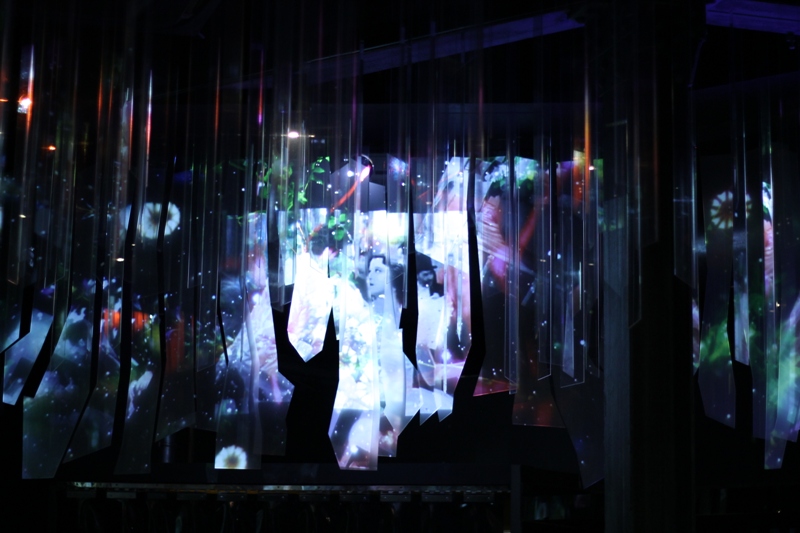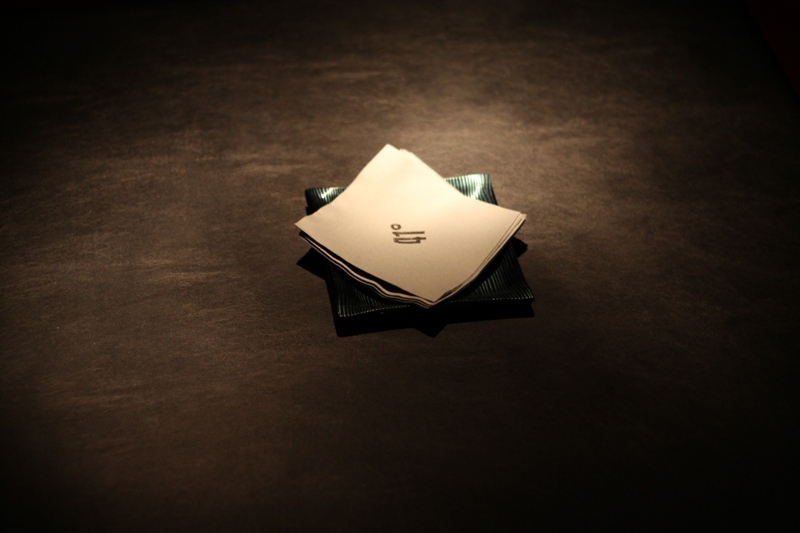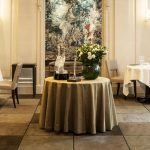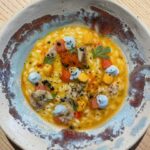“We had to kill the beast. After many years, we feared that the passion would die.”
This was said some time ago by Albert Adrià. He was talking about the Bulli, obviously. Yet, fortunately, he and his brother were totally wrong. Their passion for culinary art has never been as burning.
Anything one can write today about Ferran Adrià, after all that was said, written and thought since the Catalan genius stepped on stage, changing radically the nature of worldwide creative cooking, could be rhetorical. As a matter of fact, only few privileged had the chance to taste his culinary art.
To sit at a table in the legendary restaurant of Cala Montjoi is for many, some of us included, a mirage of undefined duration. We cannot deny that, for those who couldn’t make it, the lack of such an important gastronomic experience will always represent their strongest regret.
Being impossible to eat in this venue, at least for now, the ingenious Roses brothers have found a suitable solution: the experimental El Bulli’s culinary art in a cozy, informal, innovative and unique location, in the Catalan city par excellence. Simple and brilliant. And it couldn’t be different.
So, after two years since the last dinner served in the most famous restaurant of the last twenty years, the gastronomic empire of Albert Adrià has come to light. With four different venues – and soon the fifth will be opened – he is asserting himself as the new king Midas of worldwide gastronomy. Let’s be clear, it is not only for their name that Tickets & Co. are overbooked for the whole year.
Among all of his new ingenious creatures, we attribute great merit to 41° Experience, which had already impressed us last year.
Placed in Avinguda del Paral-lel, the street that coincides with the 41°22’34” parallel north, this is not a simple restaurant but a real 360° degrees sensorial experience, conceived by the mind of a perfectionist. You just need to grab online, in large advance, one of the eight tables (it is not too difficult but you have to pay an arguable deposit), to live out the essence of a total gustatory, olfactory, tactile, auditory and visual experience and have a complete idea of what the highly acclaimed culinary vanguard really is. All this in a tiny but comfortable space, an actual cocktail bar.
Sixteen covers, only one menu.
From the Bulli, come a few memorable dishes that made its history, but mostly come its spirit and part of the creative team among which the brilliant Argentinian creative director Sebastiàn Mazzola. He is not very well known yet, but his name will surely be heard in the next future.
Him and Alberto are also the creators of the very original Pakta, home of “Nikkei Nata in Perù circa 60 anni fa, la cucina Nikkei è un incontro tra la cultura gastronomica giapponese e quella peruviana, una sintesi di tradizione e creatività che sta cominciando a comparire nei menu di tutto il mondo. Leggi” cuisine: a hybrid between Japanese and Peruvian culture.
Nata in Perù circa 60 anni fa, la cucina Nikkei è un incontro tra la cultura gastronomica giapponese e quella peruviana, una sintesi di tradizione e creatività che sta cominciando a comparire nei menu di tutto il mondo. Leggi” cuisine: a hybrid between Japanese and Peruvian culture.
The context seems hazy, at first, but an undefined and blurry series of images projected on 20,000 crystal plates hanging from the ceiling create a relaxed, warm, almost hypnotic atmosphere, to which you get used after a while. It is an installation known as “Frosted Rain”, by the Spanish artist Javier Milara.
The images are accompanied by a musical background that changes with the different courses, giving the impression of sitting inside an artistic installation.
Questo è, più o meno, quello che si trova e vi aspetta al “Quarantunesimo”.
The images are accompanied by a musical background that changes with the different courses, giving the impression of sitting inside an artistic installation.
This is, more or less, what you will find and what will await you at the “Forty-first”.
Everything comes second, before the tastings that will be taken underneath your eyes. Preparations of few centimeters of diameter, each plate is a small shrine enclosing a supernova of flavors.
Only the moment you taste them, you can have an idea of the Adriàs’ culinary revolution.
Cold, hot, cold, sweet, bitter, cold, spicy, meat, fish, fruit, then fish, more meat, sweet eventually. Like a gym for your palate that resets, or maybe redefines, the priority standards of the ingredients.
Forty-one courses for a total of fifty snacks, divided into geographical “landscapes” from around the world, laid in a specific seasonal context (in our case, “autumn”). A culinary art that leads the guest on a journey between lands and flavors ranging from the reexamination of dishes and symbolic ingredients of the Italian cuisine, to the Scandinavian traditions, through Mexico and Peru, up to Japan, Vietnam and Thailand, without ever neglecting the Catalan tradition and the Mediterranean flavors, obviously. In alternation cocktails, wine and beer will be served. Also the marriage food-beverage is taken care of in the smallest details, as it is for the unique, wonderful tableware, a key element of the creations.
And then the service, able to guarantee the selfsame lapse of time – about 4 minutes – between one course and the other (inform them if you’ll be missing for a while). They will always be ready to clean your table and sweep out each crumb after each course.
A service that is really custom-cut. Unanimous, experienced, multilingual (our waiter spoke perfect Italian too) and ready to describe the smallest detail of each single course, as well as the story behind the idea, contributing actively to make the 41° experience unique, to be lived at least once in your life.
Picnic Cocktail, a base di fiori di sambuco Il sambuco è un genere di piante tradizionalmente ascritto alla famiglia delle Caprifoliacee, che la moderna classificazione filogenetica colloca nella famiglia Adoxaceae. I fiori del sambuco trovano impiego in erboristeria per la loro azione diaforetica. Con i fiori è possibile fare uno sciroppo, da diluire poi con acqua, ottenendo una bevanda dissetante che è molto usata in Tirolo, in Carnia... Leggi e more.
Il sambuco è un genere di piante tradizionalmente ascritto alla famiglia delle Caprifoliacee, che la moderna classificazione filogenetica colloca nella famiglia Adoxaceae. I fiori del sambuco trovano impiego in erboristeria per la loro azione diaforetica. Con i fiori è possibile fare uno sciroppo, da diluire poi con acqua, ottenendo una bevanda dissetante che è molto usata in Tirolo, in Carnia... Leggi e more.

Picnic Cocktail, on a base of elderflower and blackberries.
Autumnal landscape: we recall raspberries caramelized with wasabi Eutrema japonicum, conosciuta comunemente come wasabi o anche con il nome di ravanello giapponese, è una pianta di origine giapponese appartenente alla famiglia delle Brassicacee (o Crocifere). La pianta cresce spontaneamente in vicinanza dei fiumi in zone fredde del Giappone, come per esempio in montagna o nelle valli in quota. Dal rizoma di Eutrema japonicum si ottiene una pasta di... Leggi, pistachio with pistachio honey; grapes with lime and thyme.
Eutrema japonicum, conosciuta comunemente come wasabi o anche con il nome di ravanello giapponese, è una pianta di origine giapponese appartenente alla famiglia delle Brassicacee (o Crocifere). La pianta cresce spontaneamente in vicinanza dei fiumi in zone fredde del Giappone, come per esempio in montagna o nelle valli in quota. Dal rizoma di Eutrema japonicum si ottiene una pasta di... Leggi, pistachio with pistachio honey; grapes with lime and thyme.
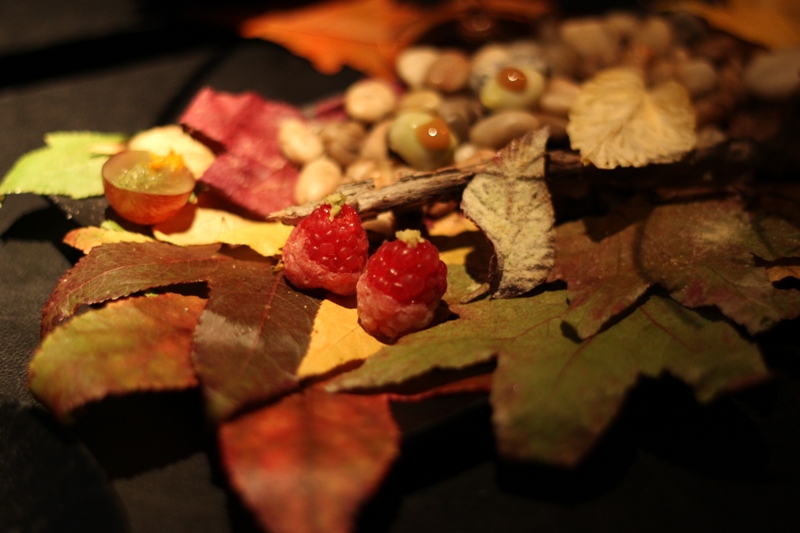
Pears infused in beet and orange juice.

Pearl of black sesame.

Olives stuffed with anchovies (one of Bulli’s classics)
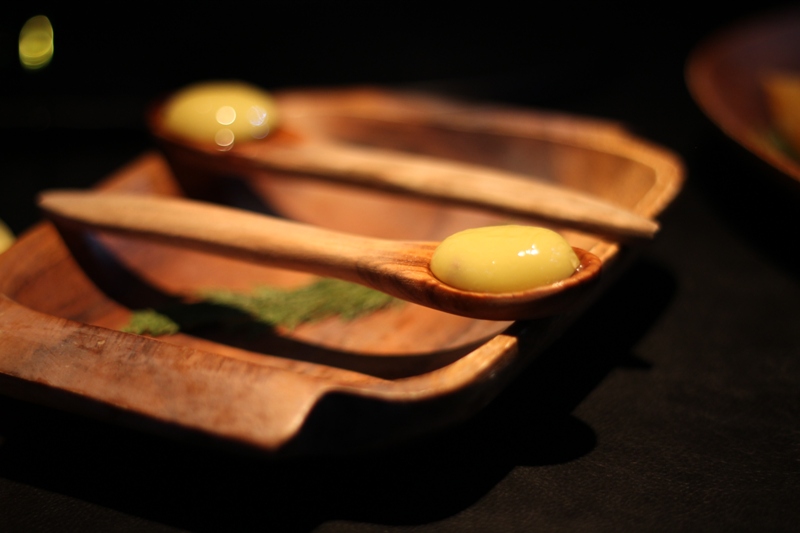
Marinated mussels with puffed potatoes and powder of “espinaler” sauce.
Vermouth Il vermut, o vermutte, oppure vermouth, in grafia francese e vèrmot in quella piemontese, è un vino liquoroso aromatizzato creato nel 1786 a Torino. È riconosciuto come prodotto agroalimentare tradizionale italiano ed è un ingrediente primario di numerosi cocktail. Il vermut si beve soprattutto come aperitivo ed entra nella composizione di molti cocktail, tra quali famoso è il Martini ma... Leggi.
Il vermut, o vermutte, oppure vermouth, in grafia francese e vèrmot in quella piemontese, è un vino liquoroso aromatizzato creato nel 1786 a Torino. È riconosciuto come prodotto agroalimentare tradizionale italiano ed è un ingrediente primario di numerosi cocktail. Il vermut si beve soprattutto come aperitivo ed entra nella composizione di molti cocktail, tra quali famoso è il Martini ma... Leggi.

Vermouth.
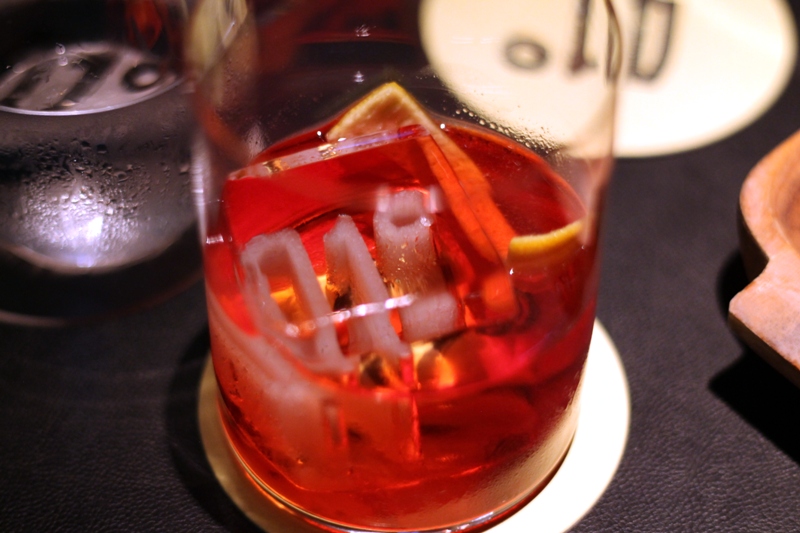
Along with “Pizzicato five” (a tribute to a Japanese pop group whose music was in the background), they serve the spicy chips of octopus tentacles and corn…

…and crispy algae with quinoa.
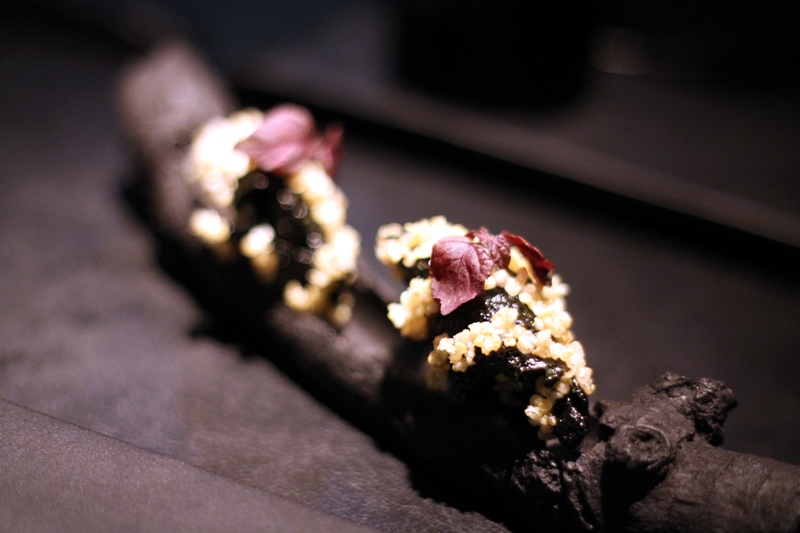
The trip to Italy starts with the funny mini home-made burrata (the only reproach, a marked sapidity of the pasta filata)…
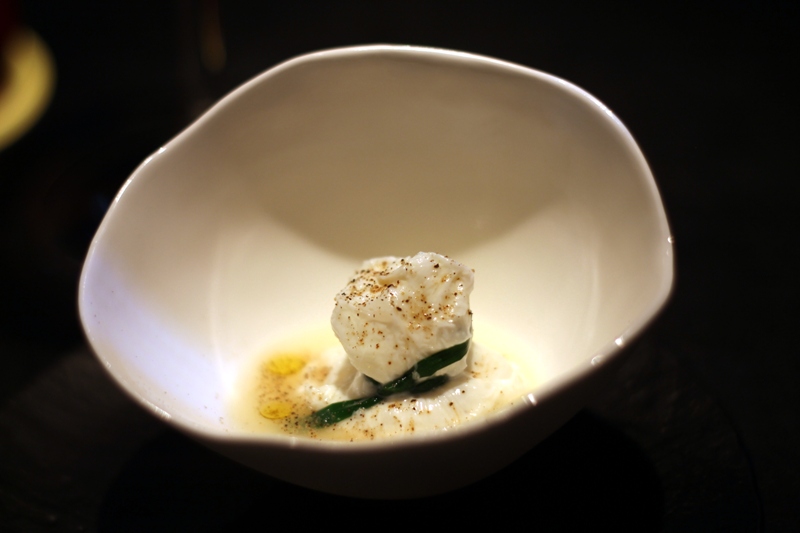
…and the reinterpretation in perfect “bullian” style of the pizza, which releases first olfactively, then in your mouth, each single ingredient (tomatoes, dried mozzarella cheese, olive oil and fresh basil gelatin).

The Italian triptych is closed by a tasty autumnal brush: dried porcini mushrooms and a cannolo with a parmesan cheese cream.

We make a step back at the Bulli, year 2004: air baguette with Iberian ham gran riserva “Joselito”.

The “northern landscape” opens with a fantastic smoked salmon with salmon eggs and sour cream, laid on a film that hides a very dense pine smoke.

Accompanied by a red fruit juice.
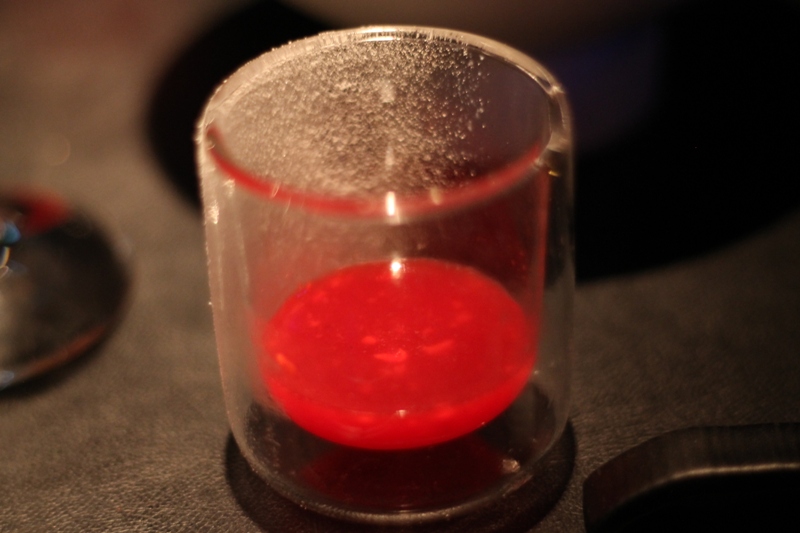
“Shot Caviar”: variation of eggs with beluga caviar, hazelnut and aubergine.

Toast and carrots. Here’s the baby carrots…

…and the toast with raw meat, shallots, dill and caprino cheese.
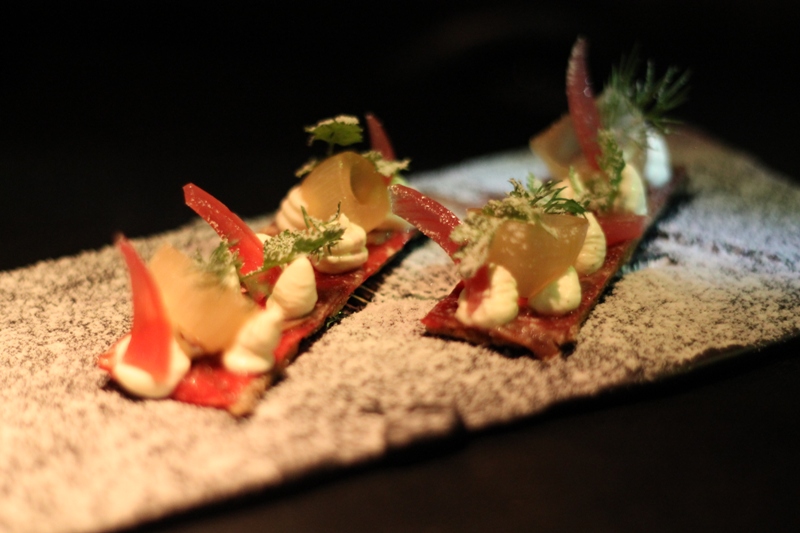
From the cold spirits to the hot ones: here for you the “Mexican landscape”: spherical Tequila…

…accompanied by agave juice

A Spanish beer: Shipa India Pale Ale…

…accompanies the extraordinary taco with “aguachile” shrimps (pepper, lime and onions).

Then, let’s go to Vietnam: the Banh Mi sandwich, stuffed with Iberian piglet cooked for 36 hours. We aren’t even halfway through, and here it comes the best part of the dinner.
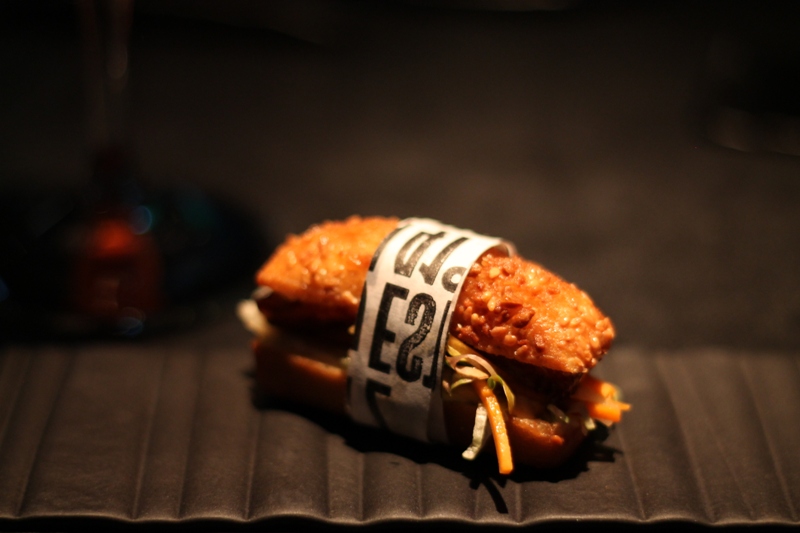
Here’s Peru. A fantastic revisited cocktail: atahualpa 2.0 (Cachaca, pineapple, peach, sugar and lime).

Ceviche La cevice è una ricetta a base di pesce o/e frutti di mare marinati nel limone, uniti ad alcune spezie come il peperoncino e il coriandolo. Preparazione tipica della gastronomia di alcuni paesi dell'America Latina che si affacciano sull'Oceano Pacifico quali: Colombia, Cile, Perù, Ecuador, Panama, Messico, El Salvador, Nicaragua, Costa Rica e Guatemala. Leggi norteño.
La cevice è una ricetta a base di pesce o/e frutti di mare marinati nel limone, uniti ad alcune spezie come il peperoncino e il coriandolo. Preparazione tipica della gastronomia di alcuni paesi dell'America Latina che si affacciano sull'Oceano Pacifico quali: Colombia, Cile, Perù, Ecuador, Panama, Messico, El Salvador, Nicaragua, Costa Rica e Guatemala. Leggi norteño.

One of the best landscapes, the Japanese one. We start with the very precious sakè Il sakè è una bevanda alcolica tipicamente giapponese ottenuta da un processo di fermentazione che coinvolge riso, acqua e spore koji. Per questo motivo viene anche chiamato "vino di riso". Non è classificabile tra i distillati né tantomeno tra i fermentati oppure ancora tra i liquori, e costituisce una categoria a parte. Il vino di riso conosciuto in Occidente come... Leggi Sohomare Kimoto Junmai Ginjo.
Il sakè è una bevanda alcolica tipicamente giapponese ottenuta da un processo di fermentazione che coinvolge riso, acqua e spore koji. Per questo motivo viene anche chiamato "vino di riso". Non è classificabile tra i distillati né tantomeno tra i fermentati oppure ancora tra i liquori, e costituisce una categoria a parte. Il vino di riso conosciuto in Occidente come... Leggi Sohomare Kimoto Junmai Ginjo.
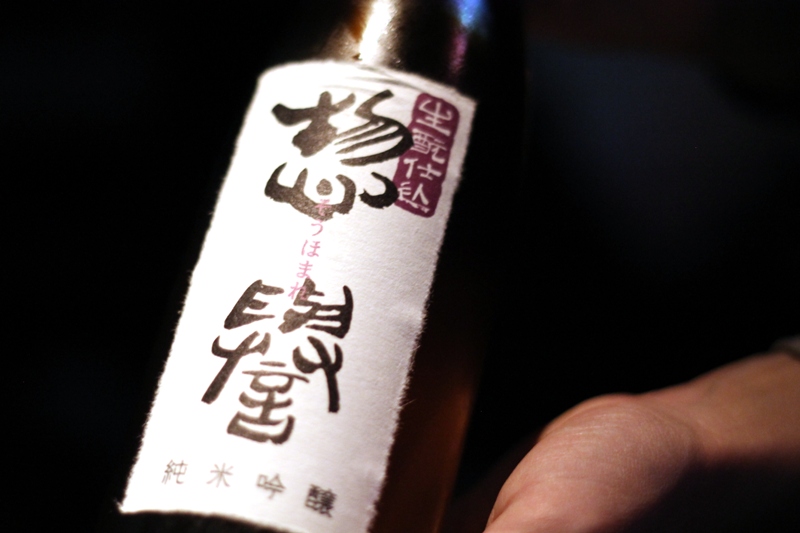
Fried sea urchin temaki. A mouthful of pure delight.

Razor clam rings with soy sauce. The tapas Con il termine spagnolo tapa, si indica un'ampia varietà di preparazioni alimentari tipiche della cucina spagnola consumate come aperitivi o antipasti. Le tapas spagnole sono preparate con ingredienti legati alla produzione alimentare mediterranea. Le tapa possono essere fredde, quando vengono preparate, per esempio, con le olive miste ed il formaggio, o calde, con polpo e calamari fritti. L'origine della parola... Leggi tradition meets Japan with a delicate Tempura
Con il termine spagnolo tapa, si indica un'ampia varietà di preparazioni alimentari tipiche della cucina spagnola consumate come aperitivi o antipasti. Le tapas spagnole sono preparate con ingredienti legati alla produzione alimentare mediterranea. Le tapa possono essere fredde, quando vengono preparate, per esempio, con le olive miste ed il formaggio, o calde, con polpo e calamari fritti. L'origine della parola... Leggi tradition meets Japan with a delicate Tempura La tempura è un piatto tipico della cucina giapponese a base di fritto misto di molluschi, crostacei e verdure. Gli ingredienti vengono intrisi, prima della frittura, in una pastella di farina di riso, acqua gasata e ghiaccio. Leggi.
La tempura è un piatto tipico della cucina giapponese a base di fritto misto di molluschi, crostacei e verdure. Gli ingredienti vengono intrisi, prima della frittura, in una pastella di farina di riso, acqua gasata e ghiaccio. Leggi.

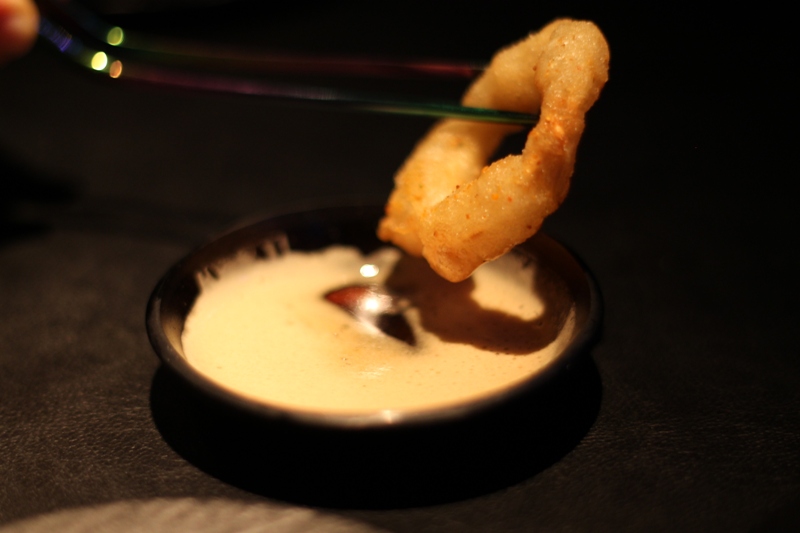
Razor clam that is proposed again in another highly refined preparation, in escabeche with pig ciccioli I ciccioli ('cicoli' in dialetto napoletano) sono un prodotto alimentare ottenuto dalla lavorazione del grasso del maiale nella preparazione dello strutto. Il grasso viene tagliato in piccole parti e viene messo a cuocere su fuoco lento così da far fondere la parte grassa e consentire l'evaporazione dell'acqua contenuta. Quando i pezzi di grasso hanno acquistato un colore giallastro vengono versati... Leggi.
I ciccioli ('cicoli' in dialetto napoletano) sono un prodotto alimentare ottenuto dalla lavorazione del grasso del maiale nella preparazione dello strutto. Il grasso viene tagliato in piccole parti e viene messo a cuocere su fuoco lento così da far fondere la parte grassa e consentire l'evaporazione dell'acqua contenuta. Quando i pezzi di grasso hanno acquistato un colore giallastro vengono versati... Leggi.

The highest peak of pleasure is reached with the “Thai landscape”. A magnificent soup of calamari and mango salad.

The delicious spicy lamb.

In so far as the surprises never end…listen, listen, it is the excellent Cos Frappato that accompanies…

…the “mountain fideua”, an Andalusian fish and meat recipe, on a base of typical Spanish mushrooms (similar to chanterelles) and cuttlefish cut like Vermicelli.

Bread, cheese and white truffle from Alba.

A glass of thirty-year Palo Cortado Vors accompanies the last salted bite.

Tart of foie gras In francese significa letteralmente "fegato grasso" ed è definito dalla legge francese come "fegato di anatra o di oca fatta ingrassare tramite alimentazione forzata”. È uno dei prodotti più famosi e pregiati della cucina francese. Esistono tipologie di 'foie gras' non derivate da animali sottoposti ad alimentazione forzata. Spesso il fegato grasso è associato all'alta cucina francese e internazionale per... Leggi and almonds.
In francese significa letteralmente "fegato grasso" ed è definito dalla legge francese come "fegato di anatra o di oca fatta ingrassare tramite alimentazione forzata”. È uno dei prodotti più famosi e pregiati della cucina francese. Esistono tipologie di 'foie gras' non derivate da animali sottoposti ad alimentazione forzata. Spesso il fegato grasso è associato all'alta cucina francese e internazionale per... Leggi and almonds.

The dessert show can begin. Here comes the mobile station of ice and liquid nitrogen…
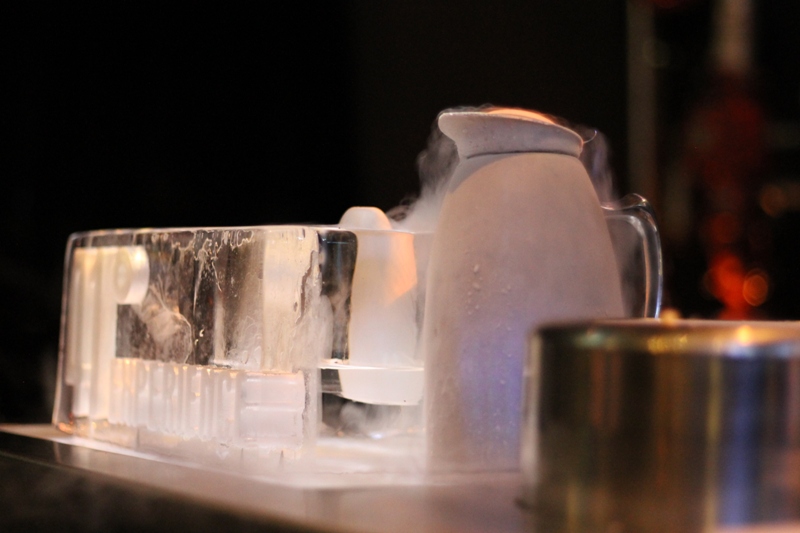
…for the Nitro Pineapple: a cream of vanilla, pineapple and Rum transformed in an express ice-cream.

Followed by a micro dried peach with mango flavor. An explosion of delight.

Figs.
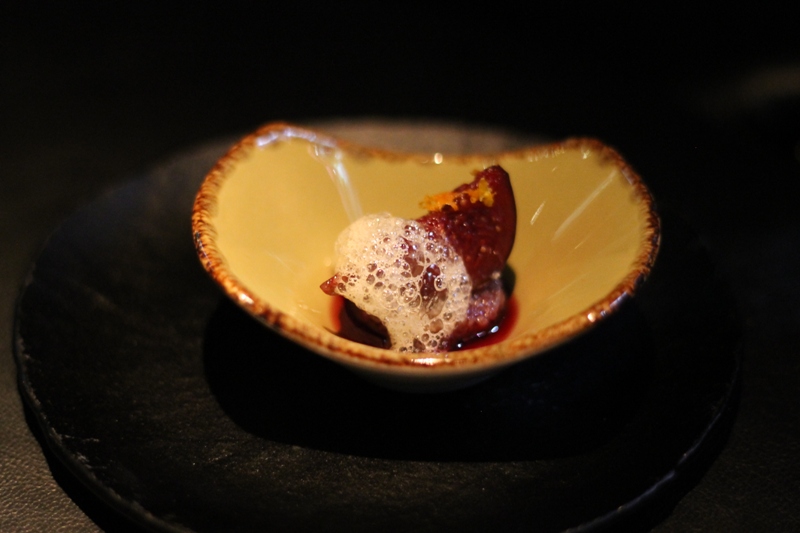
Oroley Martini. Made with Lavazza qualità oro.

Banana Musubi.

Honeycomb with passion fruit, very explosive too.

Not a cupcake but an incredible lemon pie. With the ramekin which actually consists of a very thin film of sugar.

Conclusion, with chocolates.

